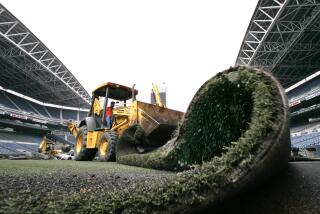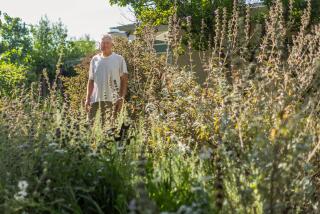The lowdown on dymondia and three other lawn alternatives
- Share via
Do you have any suggestions for drought-tolerant, kid-friendly ground cover? We’ve read that dymondia works well to fill in space between pavers but haven’t found any talk of how well this plant works as a grass substitute, spread across a yard.
Can our kids walk barefoot? Will the dymondia attract bees? And will it flourish in an area that gets sun and shade?
Julie Cho
Irvine
Many drought-tolerant, kid-friendly lawn alternatives thrive in Los Angeles and can save money and time in addition to water. As many municipalities work to reduce outdoor water use, you may be eligible for grants and rebates. Even if we were to set aside those upfront cash incentives, I’d estimate that a family replacing 1,000 square feet of grass with a smart alternative could save as much as $3,500 a year in water bills, mowing service fees and other related maintenance costs.
Dymondia comes from the Western Cape of South Africa, where the climate is similar to our own. It is drought-tolerant. It thrives in full sun and can tolerate partial shade inland. Bees tend to ignore it until the silvery foliage erupts with dainty, daisy-like flowers in summer. But the larger consideration: Anything more than light foot traffic presents problems.
To keep dymondia lush, my firm tends to use it with stepping stones in high traffic areas. When first planted, dymondia will need generous watering, thick mulch and regular weeding for about six months, or until it spreads to cover open spaces.
Dymondia is wonderful, but a few other lawn alternatives are worth consideration. Given that you’re looking for ground cover that can accommodate high levels of activity and be bee-free year-round, I think you would be happiest with a different lawn alternative. Each of the following will help you retire your mower, avoid chemical fertilizers and pesticides, and conserve water as well as create a lush, beautiful space for your family:
Carex pansa. A California native sedge, Carex pansa can take almost any amount of foot traffic. It emulates the true green of a traditional lawn, yet, because it has thicker blades (like soccer field grass), it’s tougher and needs 50% to 70% less water. Planted in plugs, it grows in 6-to-8-inch-tall mounds. The plugs form a solid ground cover in three to six months. With an occasional mow, it will be flat and foot friendly — and free of bees.
Carex glauca. With fluffy, beautiful blades — a little narrower than Carex pansa and similar in color to dymondia — Carex glauca is another good choice. It spreads rapidly, and, if you accept blades that are 6 to 8 inches tall, it never needs mowing. The effect is akin to a meadow, with blades that are exceptionally soft to the touch. If you want Carex glauca to lie flat underfoot, simply mow it once per month. It produces seed heads, not flowers, so it attracts few bees. As a spreader, it does need edging or mulch to hold it to its territory.
UC Verde. Also known as Bouteloua dactyloides, this plant looks like Carex pansa with a finer texture. It performs like a Bermuda grass lawn. A chartreuse blanket takes three to six months to establish from plugs. It will need weeding while it’s getting established, and with the exception of a brief dormant period in summer, it has great color most of the year.
—Cassy Aoyagi
Cassy Aoyagi is co-founder and president of FormLA Landscaping, www.formlainc.com. She is an accredited designer in the U.S. Green Building Council’s Leadership in Energy and Environmental Design (LEED) program, a licensed contractor and board president of the Theodore Payne Foundation for Wildflowers and Native Plants.
We welcome readers’ gardening questions, design or otherwise, at home@latimes.com. Because of the volume of mail we receive, we can respond only to inquiries selected for publication.






